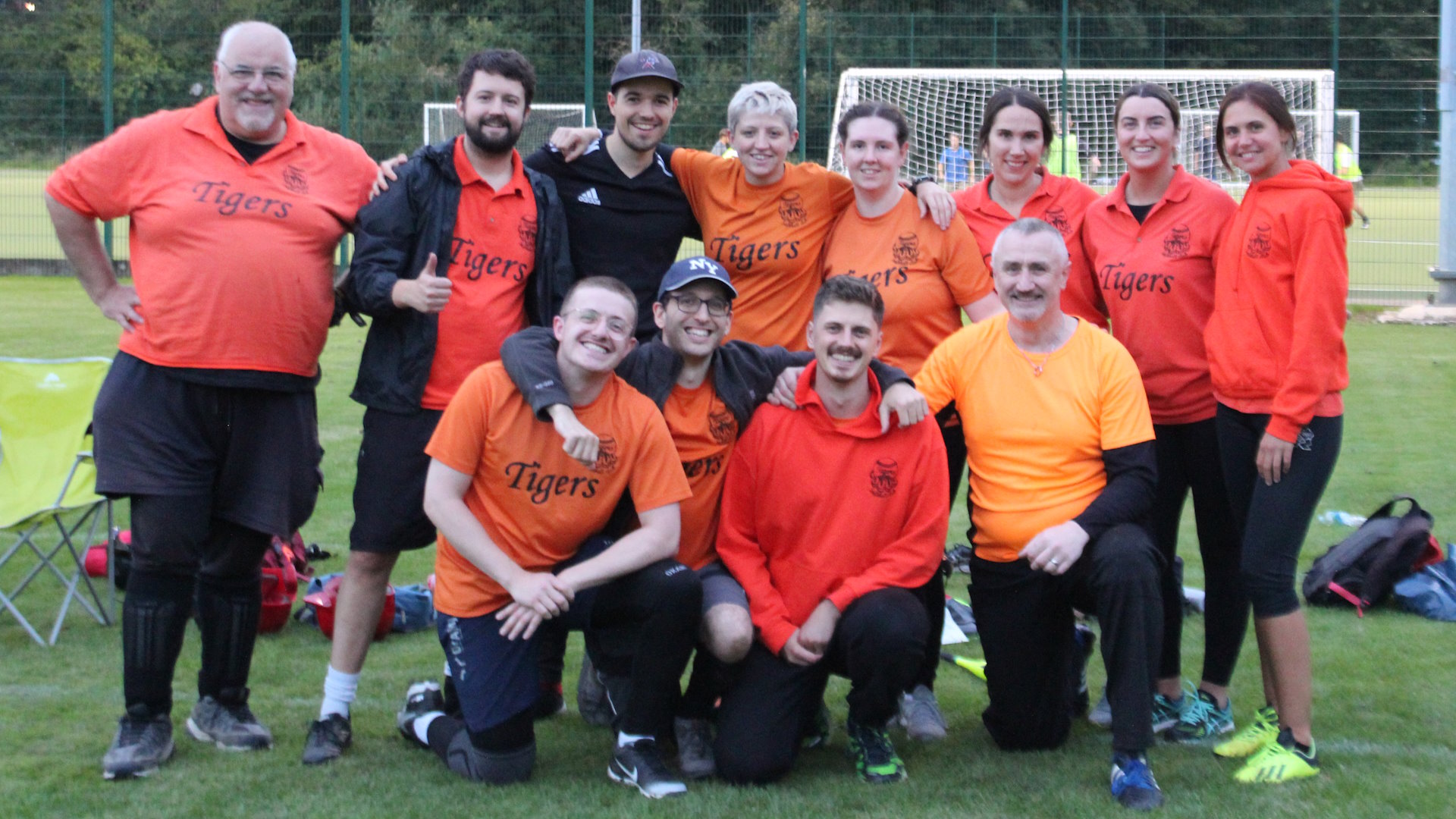The Game of Softball
Overview of the game
Softball is a bat and ball game that shares many of it's basic rules with baseball. Almost all British Softball is mixed slowpitch softball, played by two teams of ten players each, with 5 men and 5 women making up a team. The teams take it in turns to bat and field.
The basics of Softball are very simple. Each play within the game starts when a PITCHER pitches the ball to a BATTER. The batter hits the ball, then runs around as many bases as possible before the ball is retrieved and returned under control by the defensive team.
The aim of the game is to score more RUNS than the opposition and a run is scored when a player on the batting team advances around all the bases and back to where they started. Unless the batter hits the ball so far that they can run around all the bases before it's returned (a Home Run), they will have to stop at one or more bases on their way round, then wait for the next batter to hit the ball so they can advance further.
At the same time the fielding team is trying to get batters and base runners OUT. As soon as three players on the batting team have made outs, the two teams switch: The fielding team comes in to bat and the batting team goes out to the field. An inning is completed when each team has batted, and a full game consists of seven innings.
Players bat in a prearranged order (men and women bat must alternately). After the last batter in the order has hit, the first batter comes up again to bat.
A team in the field
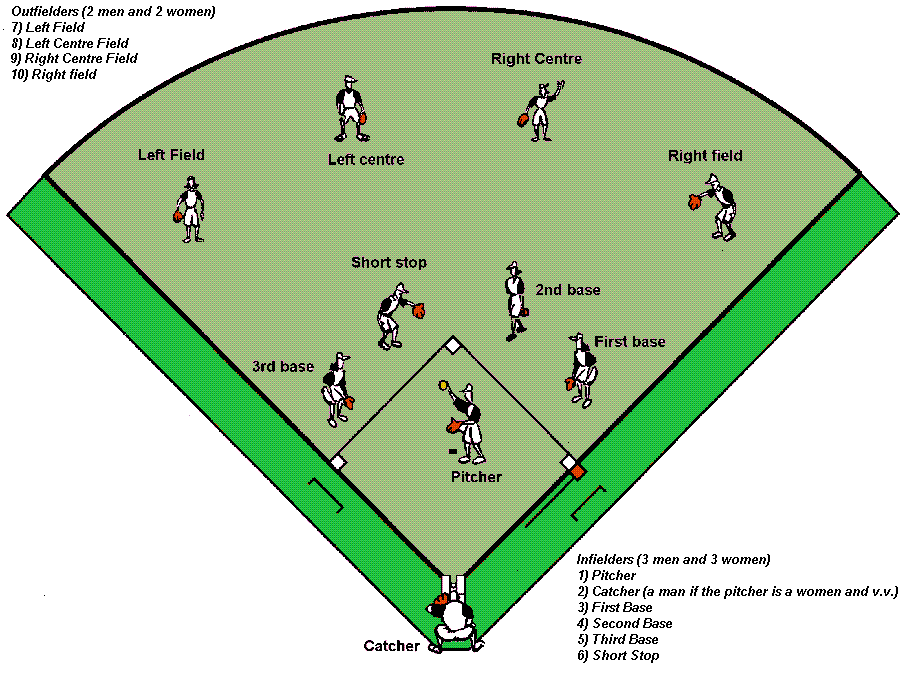
A more detailed look at the game
As we have already learnt the two teams take turn to bat and field. Let's look in a bit more detail at the mechanics of how the game works. In turn we will look at
- The playing area and the way teams set up in the field,
- The pitch, this starts the action,
- Batting, hitting the ball,
- Fielding and base running.
Whilst we do this we'll define some common softball terms that you will come across when playing.
1: The Playing Area
A Softball playing area is contained within a 90-degree angle, and is usually called a DIAMOND, because the central part of the playing field - the INFIELD - is diamond-shaped. The OUTFIELD extends outward from the infield to a boundary, either actual or notional. The playing area should look like the illustration above.
The grey-green area is known as FAIR TERRITORY and is where most of the action takes place. The bright green area is called FOUL TERRITORY, where some action can take place. Everything beyond this is called DEAD BALL TERRITORY because if this ball goes into this area all action stops. As a basic rule, the batter must hit the ball into fair territory.
You will often hear people referring to LEFT FIELD, CENTRE FIELD and RIGHT FIELD. These terms mean exactly what they say and describe the outfield as seen from the point of view of an observer looking out from Home Plate.
Play begins when the pitcher (1) standing on the PITCHER'S PLATE, tries to pitch the ball across HOME PLATE,a five-sided piece of heavy rubber, guarded by the batter, 50 feet away. Each BASE (First Base, Second Base and Third Base) is marked by a foam filled bag. For safety reasons, a double sized base is usually used at FIRST BASE.
2: The Defensive Team
The job of the defensive team, known as FIELDERS, is to catch or stop any balls hit, with the aim of preventing offensive players from advancing around the bases and scoring runs. A team in the field can be divided into 2 groups, infielders and outfielders.
Infielders
There are normally six infielders and each plays a distinct, defined, role.
- PITCHER (1): The pitcher pitches the ball to the batter from the pitcher's plate.
- CATCHER (2): The catcher is stationed behind home plate at the start of each play.
- FIRST BASE (3): The first base player guards the area near first base. This is often a busy position, as many balls will be thrown to first base in an attempt to put batters out who are running from home to first.
- SECOND BASE (4): The second base player guards the rest of the right side of the infield between first base and second bases.
- THIRD BASE (5): The third base player guards the area near third base.
- SHORT STOP (6): The short stop stands guards the rest of the left side of the infield between the second base and third base.
Outfielders
Outfield positions are not quite so rigidly defined as infield positions. In general, however, the LEFT FIELDER (7) will play in left field, and the LEFT CENTRE FIELDER (8) will play to the left of the centre field area, The RIGHT CENTRE FIELDER (9) will play to the right of the centre field area and the RIGHT FIELDER (10) will play in right field.
3: Pitching
In Slowpitch Softball, the ball is lobbed underarm and must have an arc which reaches at least six feet and no more than twelve feet from the ground. For a moment, let's ignore the main object of the game, which is for the batter to hit the ball. Suppose he doesn't? What happens then?
Balls and Strikes
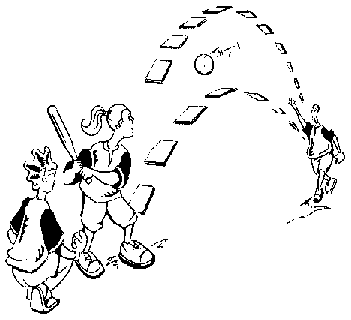
A pitched ball will be described (by the umpire) as either a STRIKE or a BALL. Basically, a strike is a good pitch and a ball is a bad one.
A GOOD PITCH
- Must be pitched from the pitching plate.
- Must have an arc of between 6 and 12 feet from the ground.
- Must not, in the opinion of the umpire, be too fast.
- Must pass between the height of the batter's knees and back shoulder as he stands at home plate in a normal batting stance.
- Must pass across some part of the Strike Zone.
Some definitions:
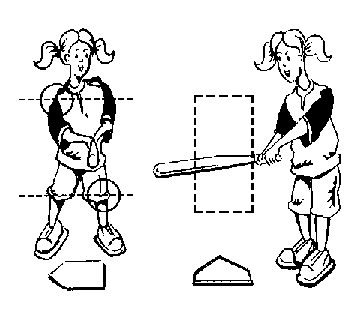
- THE STRIKE ZONE is an imaginary three-dimensional column of space corresponding to the shape of home plate. A ball passing through ANY part of this zone is called a strike.
- A STRIKE is a pitched ball which fulfils all of the above conditions. In all other cases, the pitch is a BALL, unless the batter swings at it.
- A STRIKE OUT occurs if three strikes are called against the batter and the batter hasn't managed to hit the ball into Fair Territory.
A STRIKE is called if:
- A pitch is good and the batter fails to swing, or swings and misses, or swings and hits the ball into Foul Territory (without it being caught) or into Dead Ball Territory.
- A pitch is bad (would be deemed a BALL) but the batter swings and misses it.

A WALK occurs if:
A pitcher pitches four BALLS - bad pitches which the batter makes no attempt to hit. In this case the batter will walk to first base.
4: Batting
Players bat in a prearranged order (in mixed games men and women bat alternately). After the last batter in the order has hit, the first batter comes up again. If the final out in an inning is made by, say, the fourth batter in the order, then the fifth batter will be the first to hit when the team comes in to bat again. Batters keep their place in the batting order even if they were out last time they batted.
A right-handed batter will stand to the right side of home plate (from the pitcher's point of view) and a left-handed batter to the left of home plate. Once a batter hits the ball into fair territory he/she advances counter-clockwise around the bases.
If and when you hit the ball into Fair Territory, you must run. You have no choice. You must drop the bat down and run as fast as possible to first base (and on to further bases if you think you can make them safely).
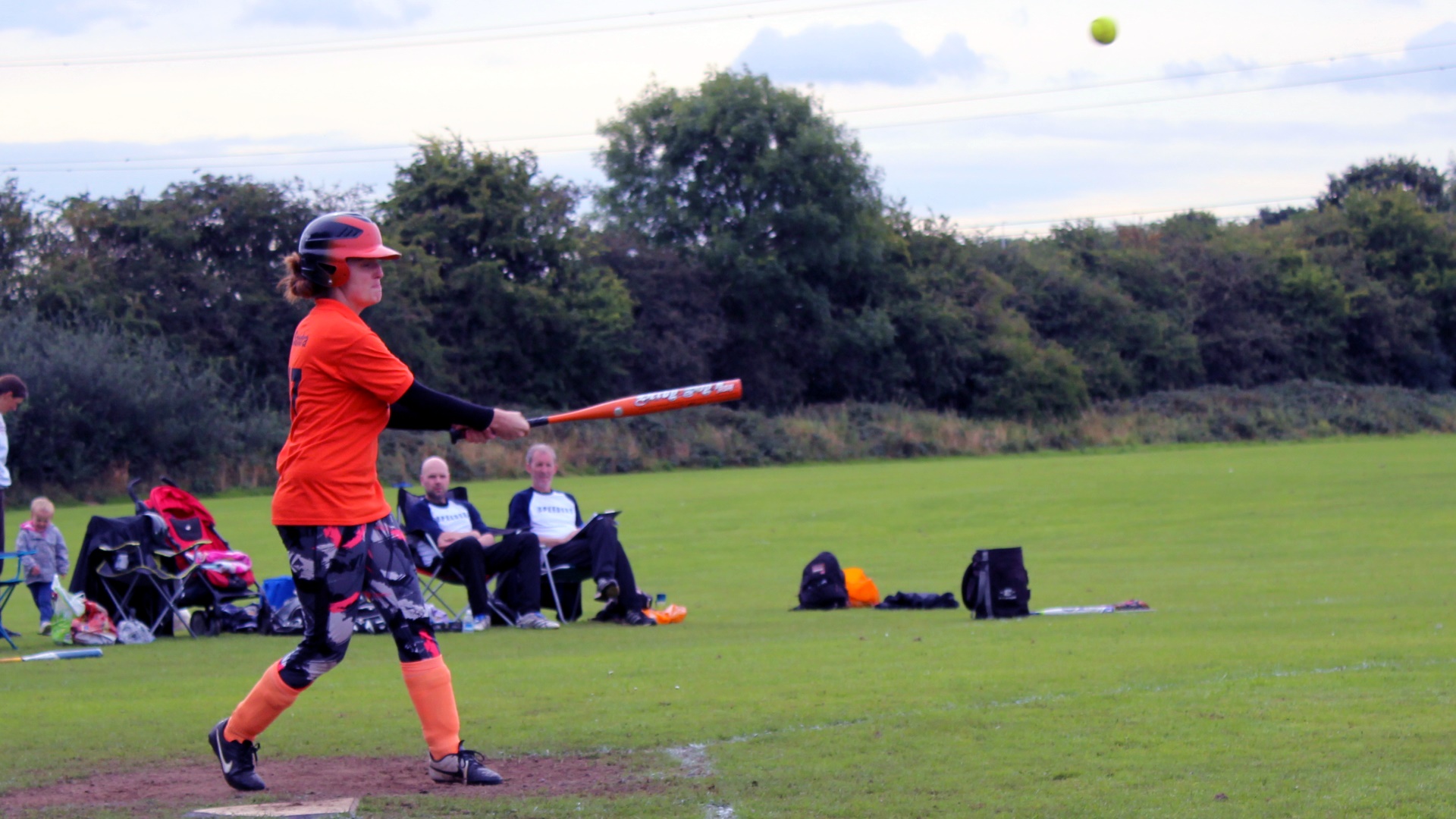
Remember that you must touch every base with your foot as you run past it, and when you decide to stop at a base (apart from first base and home plate), you must stop on it, not run past it.
FAIR AND FOUL BALLS
A ball is considered to be FAIR if:
- it lands in the outfield (i.e. in Fair Territory), and then rolls foul.
- it is hit into Foul Territory, but then rolls into Fair Territory before it passes first or third base.
- it hits either first or third base, no matter where it goes afterwards!
A ball is considered to be FOUL if:
- it is hit into the infield (i.e. in Fair Territory) but then rolls foul before it passes first or third base.
- it is hit into Foul Territory outside the infield and then rolls into Fair Territory.
NOTE: A ball touched by a fielder standing in fair territory is FAIR, a ball touched by a fielder in foul territory is FOUL.
5: Running the Bases
Once you've hit the ball you're forced to run. If you are forced to run to a base, if any defensive player is holding the ball and touches that base with any part of his body, or the ball itself, before you get there, you are OUT.
As a base runner you are never safe until you are touching a base. If at any point you are touched with the ball (whether in or out of the glove) by a fielder and you are not safely in contact with a base, you are out. This is called a TAG. Let's look at both these situations a little more closely:
Force Outs
A batter who hit's the ball into fair territory is always forced to run to first, so the fielding side can get the runner out by getting the ball to the base before the runner arrives.
Let's suppose that you have made it to first base safely and the next batter comes up to bat. You can only advance to second base or beyond if the next batter hits the ball or receives a walk BUT, if the next batter hits the ball into Fair Territory without it being caught in the air, you are forced to run towards second base because the batter-runner is coming to occupy first base and no more than one runner per base is allowed.
In any situation where you as a base runner are forced to advance, the defensive team can put you out simply by throwing the ball to a player standing on the base to which you're advancing. This is called a FORCE OUT (or Force Play). No tag is necessary, although the fielder can choose to tag you while you're between bases if he wishes.
Let's suppose that you're a base runner on first and the next batter hits a ground ball to the short stop. You are forced to run to second, the batter-runner is forced to run to first and the defensive team has a choice of two possible FORCE OUTS: you or the batter-runner. If they're feeling ambitious and there are less than two outs, they can go for both of you. If they're successful, this is called a DOUBLE PLAY.
Force plays can apply at any base. For example, if there are base runners on all three bases (this is called BASES LOADED), then all the runners are forced to run on the next hit that isn't caught in the air, and the fielders could get a FORCE OUT at any base - including home plate.
Tag Outs
You have probably already grasped the point that fielders must TAG OUT runners who are not forced to run; simply standing on the base with the ball won't do.
Say you are the first batter in the inning and you hit a DOUBLE (a hit that allows you get to second base). When the next batter hits the ball and runs toward first, you don't have to advance if you don't want to, because no one is coming to occupy your base. If you do choose to head for third, you are UNFORCED and to put you out, a fielder must tag you with the ball in hand or glove before you reach your target base. In fact, you can turn around and run back to the base you came from if that seems a wiser choice; no one is coming to occupy that base and it's still yours!

Catch Outs (ball is caught in the air)
When a batter hits the ball in the air and the ball is caught on the full the batter is out.
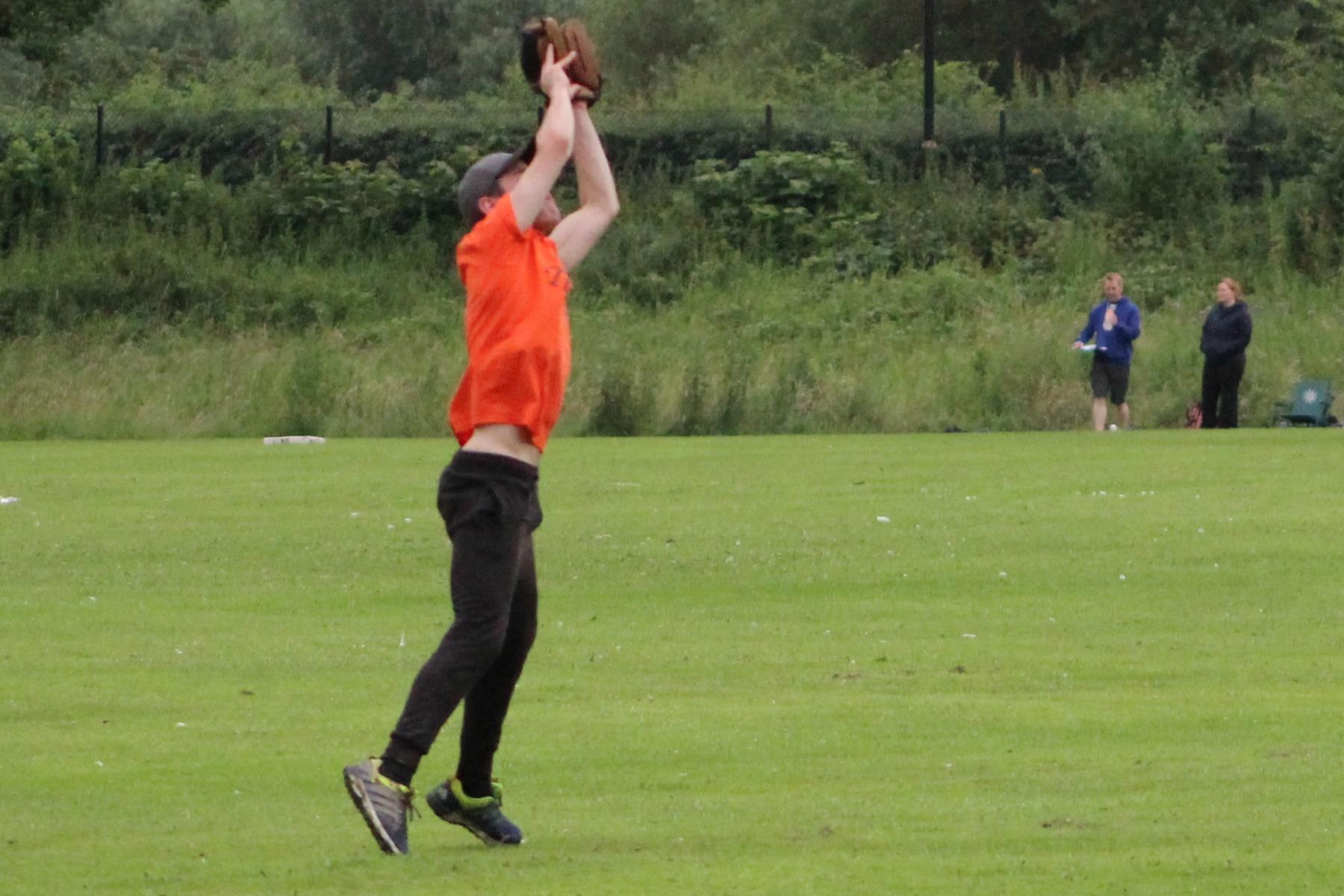
But what if you are on base when this happens ? Suppose you're on first base with less than two out and the next batter hits the ball in the air towards an outfielder (this is called a FLY BALL, or, if it's hit on a low, hard trajectory, a LINE DRIVE). Well, as soon as the outfielder catches the ball before it hits the ground (and the laws of physics tell you this will happen within seconds), then the batter is out - at which point you're no longer forced to run to second, since there's no batter-runner coming to occupy first. The force is off.
Instead, you can choose whether to advance to second or not and so the defensive team can't get you out with a Force Play. They can only get you out by tagging you with the ball: a TAG OUT or Tag Play. That's why, if the ball is hit in the air towards a fielder when you're a forced runner, you shouldn't automatically take off for the next base, because the catch might be made and the force removed.
AND HERE'S THE KEY POINT: you cannot advance to the next base on a caught fly ball unless your foot is in contact with the base you're already occupying when the catch is made, or afterwards. This is called TAGGING UP. You must tag up before you can advance after a caught fly ball. Why? it's a rule!
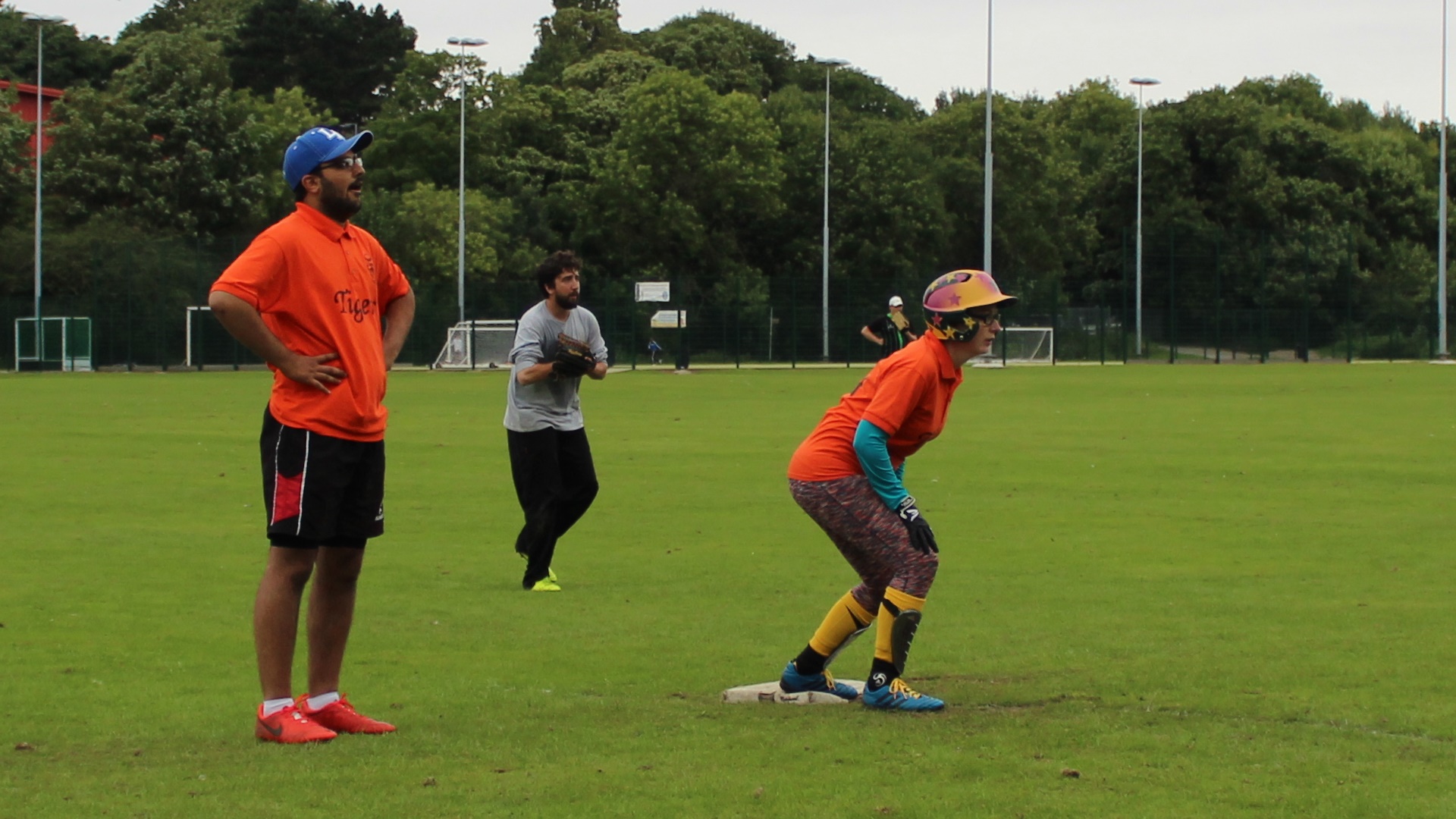
ACKNOWLEDGEMENT
This guide is based on the BSFs IDIOTS GUIDE TO SOFTBALL.
